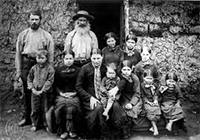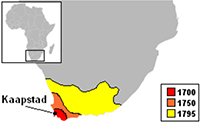The Boer Wars
Part 1: Background The Boer Wars were a series of struggles for supremacy in southern Africa between forces of the United Kingdom and settlers originally from elsewhere in Europe. 
The Boers were settlers from France, Germany, and (primarily) the Netherlands who settled in southernmost Africa in the mid-17th Century. The word Boer comes from the Dutch and Afrikaans languages and has an English equivalent of "farmer." When the Dutch Republic founded the Dutch East India Company (VOC) in 1602, it was a means to the end of increasing trade around the globe, expanding into areas not previously matters of focus. The Thirty Years War consumed Europe and European powers' colonies for three decades in the first half of the 17th Century. In the year that the war ended, 1648, a VOC ship became stranded in Table Bay, in what is now South Africa. The crew moved around onshore in order to find the means of survival until they could repair their ship. They returned to VOC headquarters, singing the praises of the newly found land. The VOC in 1652 sent an expedition commanded by Jan van Riebeek to the area; he and his crew built a fort and set out the means to establish settlements. Their success was palpable and enabled van Riebeek and his men to seize nearby Cape Town as well (calling it Kaapstad in the process). All in the settlement accepted van Riebeek as their commander. A handful of settlers wanted to strike out on their own and farm for themselves. In 1657, Van Riebeek granted their request, handing over two areas of land named Dutch Garden and Groenveveld, both near the Liesbeek River. Dutch interests in 1671 bought land from the Khoikhoi, an indigenous group, to expand the Dutch colony. 
The settlement as a whole grew quickly, morphing into a number of individual colonies, with a total population in the thousands. That number grew in 1688 with the arrival of a large number of Huguenots, refugees fleeing France after that country's monarch had revoked their protection against persecution. The colony continued to grow and spead out, reaching Algoa Bay in the mid-1750s. As the 18th Century progressed, the descendants of the original settlers found themselves enjoying more and more autonomy, primarily those who lived far away from the administrative centers. The VOC, however, still wanted to keep control of things, and some policies seemed to south African settlers incredibly irksome at the least and downright invasive at the most. The response from some Boers was to leave the colony entirely. Those who went east encountered the indigenous Xhosa, and conflict over settlement boundaries ensued. At the same time, the expansion of the colony brought its members into contact with interested parties from other European powers, particularly the United Kingdom. That contact became violent in 1795, when British forces invaded the Dutch Cape Colony at the Cape of Good Hope. In Europe at the time, France had undergone a revolution and had launched a war against Austria and other European powers. The conflict spilled over into the Netherlands, which at the same time suffered a spasm of uprising that ended in the overthrow of the Dutch Republic and the institution of the Batavian Republic. The occasional uprising against British occupiers did little to change ownership, but Great Britain handed the colony back as part of the terms of the Peace of Amiens, in 1803. As was often the case with such things, the British regained control, after another invasion a mere three years later. The British occupation was more lasting, stretching to 11 years until a treaty in 1814 made the switch in ownership permanent. During this period, both Khoisan and Xhoan tribes alternated between opposing Dutch and British forces. Next page > The Republic > Page 1, 2, 3 |
|
Social Studies for Kids
copyright 2002–2025
David White




